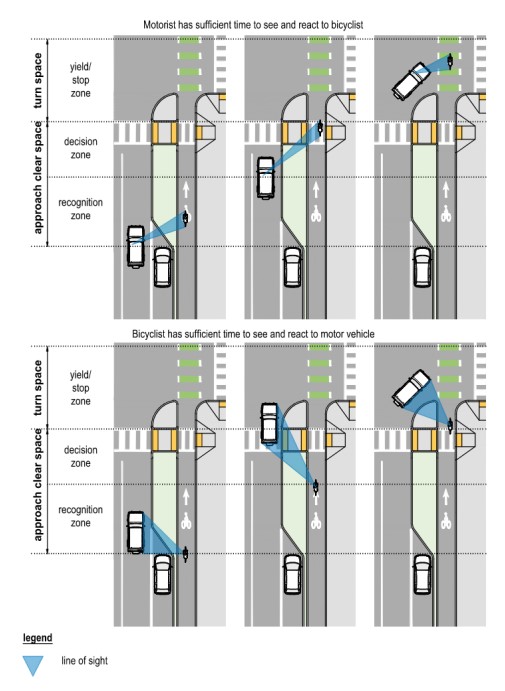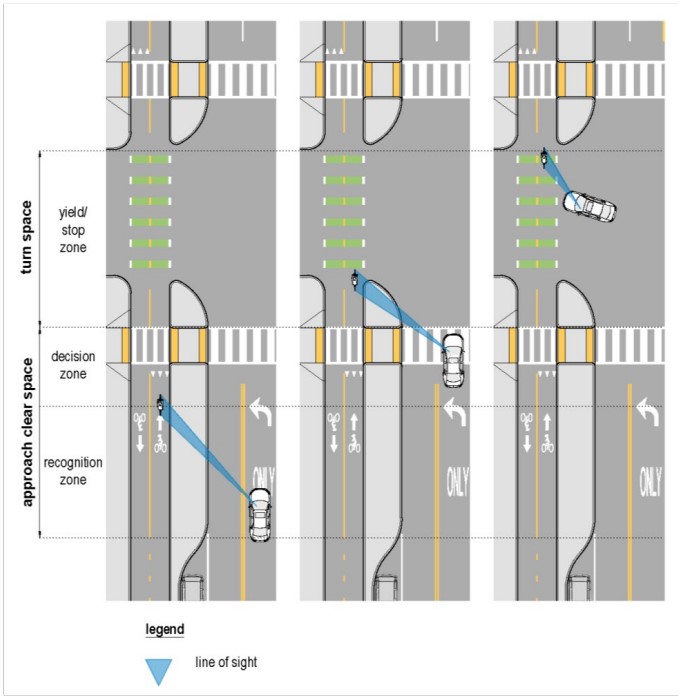18.3.5 Sight Distance
of the RDM provides detailed information about motorist Sight Distance. The
provides detailed guidance for evaluating bicyclist stopping sight distance, horizontal sight distance, and the evaluation of sight distance to establish traffic control at trail roadway intersections. The following supplements that guidance.
18.3.5.1 Bicycle Stopping Sight Distance
Adequate motor vehicle stopping sight distance is important for the safety of pedestrians and bicyclists who must cross roadways. See
for procedures for determining motor vehicle stopping sight distances.
Bicycle stopping sight distance (SSD) is the distance needed to bring a bicycle to a fully controlled stop. It is a function of the user’s perception and brake reaction time, the initial speed, the coefficient of friction between the wheels and the pavement, the braking ability of the user’s equipment, and the grade. The coefficient of friction for the typical skidding bicyclist is 0.32 for dry conditions and 0.16 for wet conditions. A perception and brake reaction time of 2.5 seconds should often be used, though 1.5 seconds may be used where braking or stopping is more expected, such when approaching intersections where scanning for conflicts is anticipated. Stopping sight distance can also be calculated using the formula shown in
. The table in
shows the minimum stopping sight distance for a typical adult bicyclist under wet conditions at various design speeds and grades based on a total perception and brake reaction time of 2.5 seconds

Figure 18-7: Stopping Sight Distance Formula and Table
18.3.5.2 Intersection Sight Distance
establishes a range of recommended sight triangles that correspond to requirements for motorists to have sufficient space to identify, react, and potentially yield to other traffic at an intersection based on the traffic control applied at the intersection.
Applying the sight triangle requirements provided in
will generally result in sufficient sight distance for bicyclists when operating on bicycle facilities located within the street, such as shared lanes, bike lanes, and separated bike lanes. Sight triangles should remain clear between 2.3-ft and 7-ft measured above the ground surface to account for the wide range of bicyclist eye heights and recumbent bicyclists as well as to ensure the visibility of child bicyclists to approaching motorists.
Intersections of Shared Use Paths and Roadways should be calculated using a combination of Motorists SSD requirements along their travel path and bicyclist SSD along their travel path. The
provides additional discussion on these sight triangles considerations.
18.3.5.3 Sight Distance Considerations at Intersections with Separated Bike Lanes and Sidepaths
At intersections with separated bike lanes and sidepaths it is important to evaluate potential right and left turning conflicts across the bikeway with right turning motorists (Case A) and left turning motorists (Case B), both of which create two unique sight triangles. For each case, there are two yielding scenarios based on who is closest to the intersection for which the provision of adequate sight distance between users is paramount.
18.3.5.3.1 Turning Motorist Yields to (or Stops For) Through Bicyclists
This scenario occurs when a through moving bicyclist arrives or will arrive at the crossing prior to a turning motorist, who must stop or yield to the bicyclist who is likely to be within the intersection at the time the motorist turns. This is shown visually in the top portion of
. Vertical elements near the intersection to separate bicyclists, including on-street parking, should be set back sufficiently for the motorist to see the approaching bicyclist providing the motorist sufficient time to slow or stop before the conflict point.
18.3.5.3.2 Through Bicyclist Yields to (or Stops For) Turning Motorist
This scenario occurs when a turning motorist arrives or will arrive at the crossing prior to a through moving bicyclist. This is shown visually in the bottom portion of
. This scenario can occur when a bicyclist approaches after a motorist has stopped and yielded to other people crossing in the intersection and the crossing is clear for the motorist to proceed. The motorist may begin turning as the bicyclist approaches, requiring the bicyclist to slow and potentially stop while the motorist completes the turning movement.
To provide sufficient sight distance between turning motorists and approaching bicyclist, it is necessary to provide a minimum approach clear space. This clear space is calculated by the determining the amount of space traveled by each user navigating the approach before they reach the conflict point which occurs in each of these zones:
- Recognition zone– the approaching bicyclist, motorist, or pedestrian has an opportunity to see the other user(s) and evaluate their respective approach speeds;
- Decision zone– the bicyclist, motorist, or pedestrian identifies who is likely to arrive at the intersection first and adjusts their speed to yield or stop if necessary; and
- Yield/stop zone– a space for the motorist or bicyclist to yield or stop, if necessary
The key design parameter to determine the necessary approach clear space is the turning speed of the approaching motorist which is influenced strongly by the effective turning radius available to them to execute the turn. It is preferable for turning motorist speeds to be below 15 mph at locations where they are expected to stop or yield to pedestrians and bicyclists in a crossing.
presents approach clear space values assuming the bicyclist design speed is 15 mph and that stopping is occurring under wet conditions and on flat terrain. As both bicyclists and motorists should be expecting potential conflict or the need to stop or yield, reaction times are assumed to be 1.5 seconds. The approach clear space may be increased or decreased to account for other approach speeds or reaction times if they are known. The values for clear space in
are measured back from the point of curvature of the motorist’s effective turning radius (i.e., fastest path), which represents the location where the motorist will have decelerated to the turning speed. This location may or may not be the curb line point of curvature.
Effective Vehicle Turning Radius | Vehicular Turning Speed | Approach Clear Spa |
<18 ft | <10 mph* | 20 ft |
18 ft | 10 mph | 40 ft |
25 ft | 15 mph | 50 ft |
30 ft | 20 mph | 60 ft |
≥50 ft | 25 mph | 70 ft |
*Most low volume driveways and alleys

Figure 18-8: Yielding Scenarios Case A
(Refer to the
and
for additional signing and pavement marking guidance.)
18.3.5.3.3 Case A: Right-Turning Motorist Across Separated Bike Lane or Sidepath
depicts Case A, which applies when a motorist is making a permissive right turn across a bikeway. In this case the motorist will be decelerating for the right turn and their turning speed will be controlled by the intersection corner geometry and width of the receiving roadway.
identifies the minimum approach clear space, measured from the point of curvature of the motorist’s effective turning radius, which represents the location where the motorist will have decelerated to the turning speed. This location may or may not be the curb line point of curvature. Providing the appropriate clear space provides the necessary sight lines between motorists and bicyclists to stop (or yield) as appropriate. For locations with two-way separated bike lanes or sidepaths, additional approach clear space is not typically required as the recognition zone between the counter-flow bicyclist movement and the right-turning motorists should exceed the recommended sight distances.
18.3.5.3.4 Case B: Left-Turning Motorist Across Separated Bike Lane or Sidepath
depicts Case B, which applies when a motorist is making a permissive left turn across a bikeway. On two-way streets with a two-way separated bike lane or sidepath, there are two sight lines that should be maintained. A left-turning motorist approaching a turn needs a line of sight to bicyclists approaching from the same direction.
identifies the minimum approach clear space based on the effective turning radius for the left-turning motorist.
The provision of Bike Case A for motorists making a right-turn across a two-way bikeway provide the necessary line of sight between a left-turning motorist and a bicyclist approaching from the opposite direction. On one-way streets with a left-side separated bike lane or sidepath, Case A should be applied for left turns as it has the same operational dynamics
On streets with two-way traffic flow, the operational dynamic of a motorist looking for gaps in traffic creates unique challenges that cannot be resolved through improving sight distance. This is a challenging maneuver because the motorist is primarily looking for gaps in oncoming motor vehicle traffic and is less likely to scan for bicyclists approaching from behind. Unlike for Case A where the motorist is decelerating towards the crossing, the motorist in Case B will be accelerating towards the crossing once they perceive a gap in traffic. This creates a higher potential for conflicts on roads with the following conditions present:
- High traffic volumes and multiple approach lanes;
- Higher operating speeds; and
- High left turn volumes.
- High volumes of right-turn-on-red motorists from the intersecting side street, where turning motorists:
- may not be scanning for bicyclists or pedestrians approaching from the right; or
- block the crosswalk requiring bicyclists and pedestrians to cross behind them limiting their visibility to left-turning motorists from the main roadway.
Where it is not feasible to eliminate high-speed and high-volume conflicts through signalization or other traffic control, it may be necessary to reevaluate whether turns should be permitted, whether a sidepath or two-way separated bike lane is appropriate at the location, to provide adequate space for the motorist to complete the turn and then stop or yield to potential conflicts with crossing bicyclists and pedestrians with a protected intersection configuration (see
).

Figure 18-9: Intersection Sight Distance Case B
(Refer to the
and
for additional signing and pavement marking guidance.)